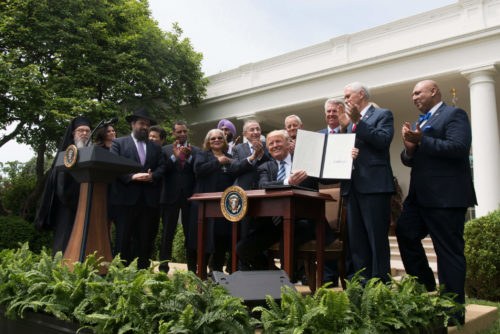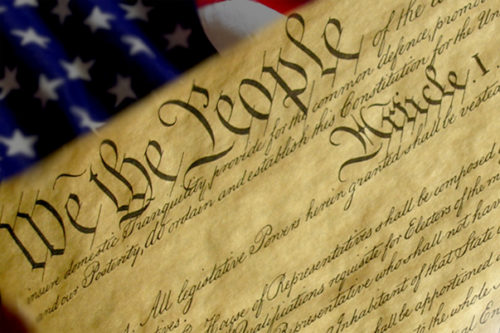UNITED STATES — President Donald J. Trump’s latest executive order is titled “Promoting Free Speech and Religious Liberty.” While some readers may be scratching their heads wondering why the current administration feels the need to promote the U.S. Constitution’s guaranteed First Amendment rights, others may feel that the little age-old document needed a good dusting off, and a signal boost.
However, the executive is order is not aimed at simply lifting up what is already clearly written into national law, but rather it is aimed, theoretically, at defining it, directing it, and, as some believe, suffocating it.

“President Donald J. Trump is applauded by gathered religious leaders, Thursday, May 4, 2017, as he displays his signature on the Executive Order Promoting Free Speech and Religious Liberty.” (Official White House Photo by D. Myles Cullen).
During the election process, Trump and running mate Mike Pence advocated for the dismantling of the now infamous Johnson Amendment. As we reported in the past, the Johnson Amendment was implemented in 1954 to prevent nonprofit organizations from influencing politics. All organizations with federal tax-exempt status are limited in their ability to engage in various election and lawmaking processes. This includes both secular and religious institutions.
At the 2016 Republican National Convention, Trump said:
At this moment, I would like to thank the evangelical and religious community in general who have been so good to me and so supportive.You have much to contribute to our politics, yet our laws prevent you from speaking your minds from your own pulpits. An amendment, pushed by Lyndon Johnson many years ago, threatens religious institutions with a loss of their tax-exempt status if they openly advocate their political views. I am going to work very hard to repeal that language and protect free speech for all Americans.
Since that point, the Johnson Amendment has become one of the focal points of the administration’s work. It wasn’t until Thursday that Trump acted on his campaign promise, or at the very least, moved toward acting on that promise.
Despite this recent push, the debate over the need for additional religious-freedom legislation did not begin with the 2016 election cycle. In fact, Vice President Mike Pence was embroiled in such a battle in 2015 when he was still governor of Indiana.
During that state legislative session, Pence signed into law what was then considered the most controversial state religious freedom restoration act (RFRA). However, after signing, Pence was pressured by both state Republicans and Democrats, as well as national organizations and private corporations, to amend the act with language that would prevent discrimination against the LGBTQ+ community.
Since coming to the White House, Pence has reportedly been pushing for Trump to enact a religious-liberty executive order. Thursday’s signing is considered a “key win” for the Vice President’s own personal agenda.
The RFRA debate itself is older than Pence’s state legislative efforts; it has been ongoing since the 1990s. While not all U.S. states have RFRAs in place, the federal government as a whole does (U.S. Code 42, chapter 21B § 2000bb). That RFRA was signed into law by President Bill Clinton in 1993.
The basic premise of these acts is to “restore” religious freedom which, in and of itself, is an odd concept. “Restoration” assumes that something is deteriorating or is completely gone. With the exception of perhaps the paper on which the Bill of Rights was originally written, the First Amendment is still very much intact.
Regardless of that point and the overarching presence of constitutionally protected rights, the federal RFRA seeks to clarify or more specifically direct religious freedom actions within the public sphere. Why? As explained in the 1993 federal RFRA’s findings, “laws ‘neutral’ toward religion may burden religious exercise as surely as laws intended to interfere with religious exercise.”
Therefore, as it posits, RFRAs are needed to ensure that the government, state or federal, does not burden a person or organization with its standing neutral laws and constitutional protections.
That is where the problem lies. One man’s expression is another’s burden.
For example, this issue applies directly to cases of prayer in school, invocations before legislative meetings, or religious monuments on publicly-owned property. While some people might feel compelled to openly pray before a class or a city council meeting, a neutral law aims at creating a neutral public environment by placing restrictions on these types of religious expressions.
Those people who do enjoy such prayer may, in turn, believe that they are burdened by the legal restrictions and even go so far as to say that their constitutional rights have been violated. However, if the practice is allowed, the expression becomes equally a burden to those people not of the expressed religion. The question then becomes, whose burden is more important?
The neutral law, as a result, stands as a means to maintaining a peaceful and safe public square and, thereby, is a sacrifice to living in community.

(U.S. Air Force graphic)
RFRA debates aside, the efforts to micromanage religious freedom legislation continues on as is evident by Thursday’s executive order. Before the document was made public, the ACLU was poised to sue again. But after the order was released, an ACLU spokesperson said, “We thought we’d have to sue Trump today. But it turned out the order signing was an elaborate photo-op with no discernible policy outcome.”
Americans United agreed, saying, “In reality, this section of the executive order doesn’t really do much. The false rhetoric Trump continues to spread about the Johnson Amendment, however, is dangerous. It is intended to shape the public’s understanding of the law and is a setup for repeal efforts.”
So what does the new executive order say? What changes did the new law put into place?
The answer is: not much.
Section two does speak to the administration’s concerns over the Johnson Amendment. It prohibits executive departments, particularly the Department of the Treasury, from taking “any adverse action against any individual, house of worship, or other religious organization on the basis that such individual or organization speaks or has spoken about moral or political issues from a religious perspective.”
Religious nonprofits can no longer be penalized, necessarily, for speaking publicly in support of or against a candidate for public office. However, it is important to remember that the Johnson Amendment is still in place. Trump cannot repeal the 1954 tax code. That would take, quite literally, an act of Congress.
It is also important to note that the executive order does not excuse secular nonprofits, which are also limited by the Johnson Amendment.
In section three of the executive order, Trump asks “the Secretary of the Treasury, the Secretary of Labor, and the Secretary of Health and Human Services [to] consider issuing amended regulations […] to address conscience-based objections to the preventive-care mandates.”
This gets into RFRA language regarding burdens, and could potentially lead to the bigotry most feared by minority populations, specifically the LGBTQ+ community with regard to health care. Using language like the protection of “conscience-based objections” creates a dangerous grey area – one that plagued Pence and the Indiana RFRA law in 2015.
However, section three of the document is merely an advisement, and not an action. The order only requests that these federal agencies consider amending their mandates. Nothing has actually changed.
What is more interesting and troubling is the wording found in section one of the executive order. Using national nostalgia and invoking the “Founding Fathers,” the document nicely suggests that the U.S. has always been a place where “religious people and institutions were free to practice their faith without fear of discrimination or retaliation by the Federal Government.”
That is well and good. Warm and fuzzy, even.
However, the sentence prior reads, “The Founders envisioned a nation in which religious voices and views were integral to a vibrant public square.”
This statement alone proposes a national ideology that allows for the integration of public space and religious space. It moves in the exact opposite direction of the First Amendment’s spirit of separation of church and state.
This is what Americans United might consider part of the administration’s “continued false rhetoric.” The executive order employs patriotism and a connection to a collective history to suggest the presence of a national ideology that does not exist.
While people of all ilks know that faith, ethics, morality, and belief cannot be fully separated from action in any sphere of life, there is a sacrifice that must happen for the sake of the greater community to thrive. The dangers of an ideology based on the integration of church and state, or church and the public square, move closer to a government based on a dominant theology.
That, in the end, would become a substantial burden for anyone outside of the religious majority.
As of this point, watchdog organizations largely believe that the executive order is just, as the ACLU said best, a publicity stunt to appease conservative Republicans. However, they are guarded, because the order does appeal to a “false rhetoric,” and may be paving the way for a more aggressive action of this kind in the future.
The Wild Hunt is not responsible for links to external content.
To join a conversation on this post:
Visit our The Wild Hunt subreddit! Point your favorite browser to https://www.reddit.com/r/The_Wild_Hunt_News/, then click “JOIN”. Make sure to click the bell, too, to be notified of new articles posted to our subreddit.
